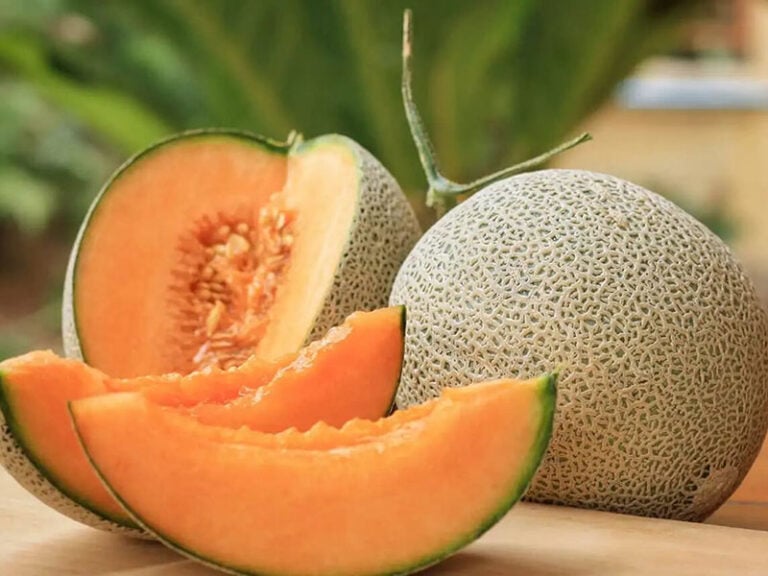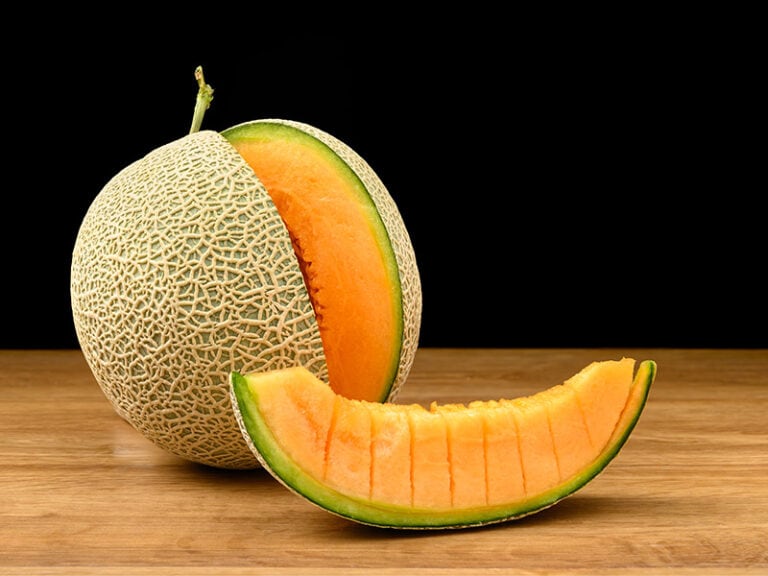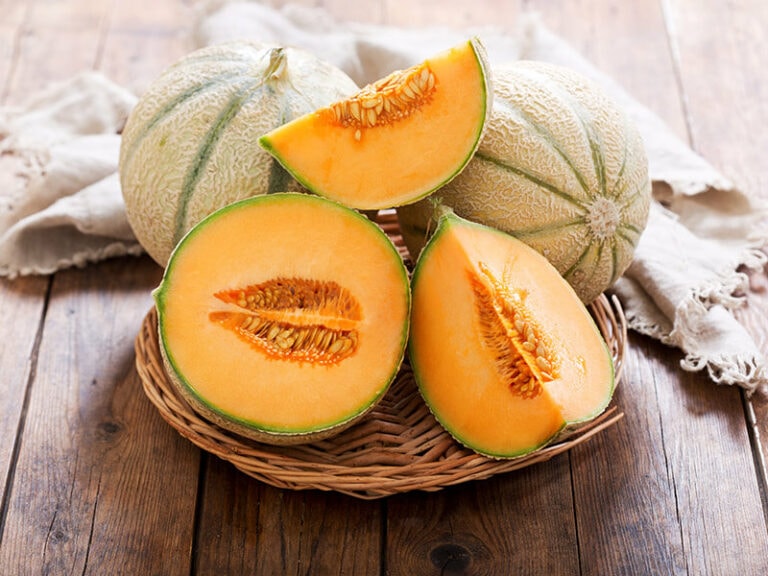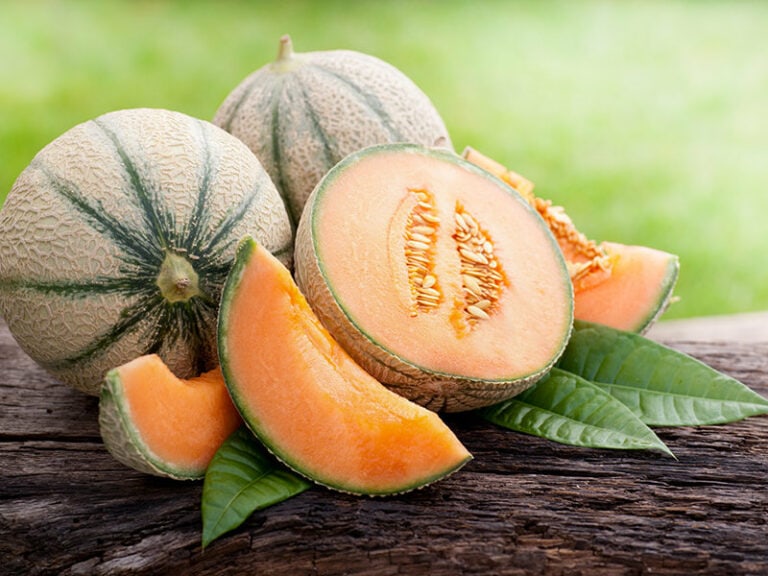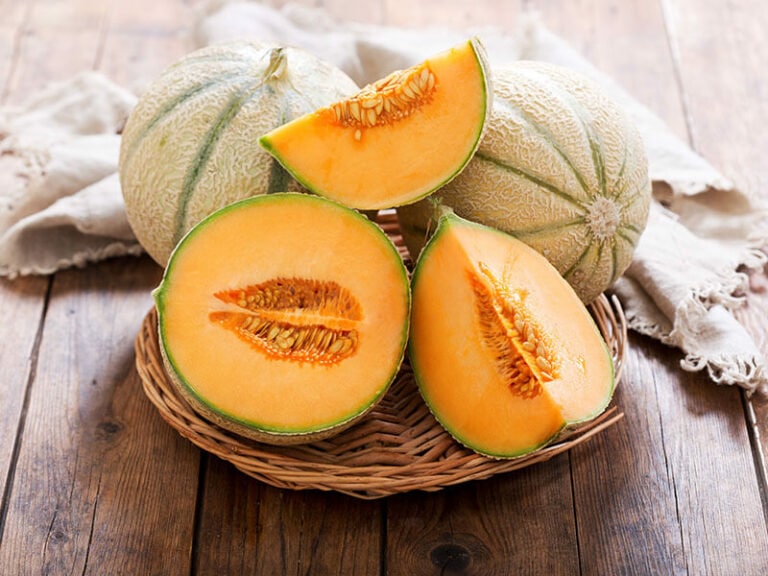Are you struggling with how to cut cantaloupe? I can tell that you’re not alone! Since many people used to come to the grocery store and just pick up the cut ones wrapped in plastic, they don’t really know how to deal with a whole cantaloupe.
If anything, some might even have trouble identifying what a whole cantaloupe looks like. Some might not be able to distinguish between cantaloupes and muskmelons, making it even more troublesome for certain people when it comes to dealing with an entire cantaloupe.
Though peeling and cutting a big fruit may look complicated, don’t let it prevent you from enjoying the fresh ripe cantaloupe. There’s nothing better than having a bite of this juice and refreshing fruit in the middle of the day! Keep scrolling for delighted information!

Why Should You Buy Whole Cantaloupe Rather Than The Prepared Ones?

Like most fruits, all types of cantaloupe are good for your health; it contains a magnificent amount of vitamin C, B9, and most importantly – beta-carotene – a nutrient that will either transfer into vitamin A after consumption or activate antioxidants of your body (1).
In fact, though cantaloupe tends to have a sweet taste, it’s one of the best low glycemic fruits that can be added to your weight loss diet, such as a fun and tasty breakfast for a hot summer day. Plus, there’s nothing that can beat a fresh, chilled cantaloupe snack on hot days.
However, the cut cantaloupes that you can find in the grocery store or supermarket tend to go wrong just after two days or less; and the plastic wrap on them is not so good for either your health or the environment.
Moreover, the rich nutrients will be decreased quickly and be a perfect house for bacteria to grow on. In contrast, these precious vitamins will be protected better by the skin if you have a whole cantaloupe.
Therefore, consider purchasing a whole cantaloupe with the proper freshness and ripeness, then store it in your kitchen or the fridge. When you’re ready to enjoy your juicy and delicious cantaloupe, go ahead and cut it with the methods that I’ll cover below.
Get Everything Ready Before Cutting Cantaloupe
The rough rind of cantaloupe may look intimidating and make you hesitate to buy a whole fresh one. The good news is cantaloupe’s rind is actually thin and not as challenging as it looks; you’ll realize it as soon as you cut through its flesh.
The only problem with the rind is the netted surface is the perfect element for bacteria to grow on and for dirt to stay. And cantaloupe is often grown on the ground; its skin can easily get contaminated (2).
Therefore, always rinse it with cool water first since you can’t know whether your cantaloupe is planted on the ground or rig; in addition, you can use a stiff vegetable brush to clean the skin more efficiently.
After washing the rind, you will now need to gather these:
- First and obviously, a fresh cantaloupe; whether it’s chilled in the fridge or at room temperature, it makes no difference in cutting.
- Knife, I would recommend a chef’s knife for cutting cantaloupe. Use a good honing steel with an ergonomic handle to sharpen your knife if it’s a bit blunt. This will make it much easier to slice through the cantaloupe’s rind.
- A cutting board of any type to prevent the juice from leaking onto your counter. Bamboo cutting boards need specific techniques to clean, so if your board is made from bamboo, ensure it’s 100% sanitary. Otherwise, you’ll risk contaminating your cantaloupes.
- A tablespoon to remove the seeds.
- Last but not least, always wash your hands before cutting.
See how to clean your cantaloupe properly before cutting.
5 Straightforward Methods To Cut Your Cantaloupe Like A Pro
In this section of the article, I’ll show you 5 methods to cut your cantaloupe into halves, wedges, slices, finger-sized cubes, and spheres without compromising the cantaloupe’s beautiful color. You can pick the most straightforward way, or a delicious-looking cutting, feel free to choose.
Method 1: Cutting Cantaloupe Into Halves
This is the most low-effort method, but before getting to any cutting methods, you will want to cut the stem ends first and remove the seeds. This will save a lot of your time and effort afterward. You can identify these stems as the spots where it has grown from the vine.
Once you’ve cut both ends of the cantaloupe, you can then peel it if you mind the rind, and it’ll be easier to slice – I’ll cover this as well. However, you’ll notice that the fruit will leak more juice onto your cutting board, and you’ll have less option to shape your cantaloupe.
Step 1: Trimming Both Ends
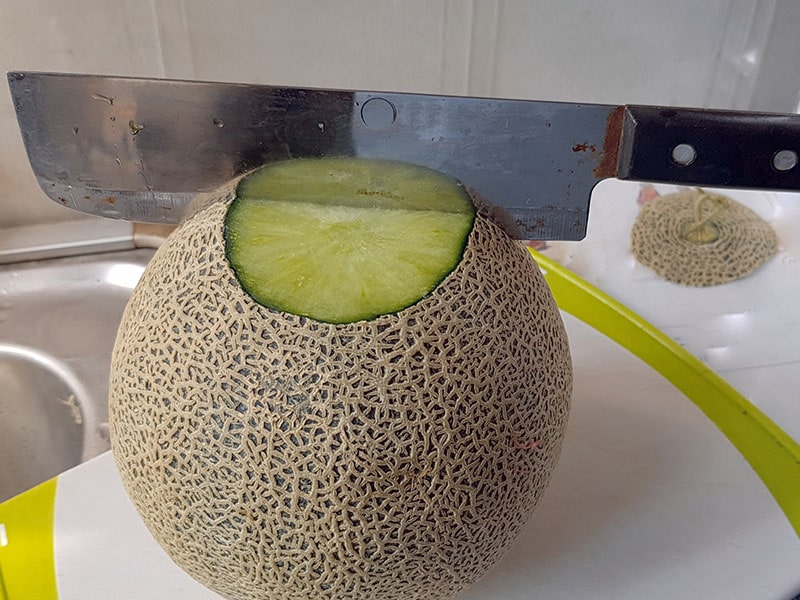
Lay the cantaloupe on its side, then simply both ends with the sharpest section of your knife’s body while holding it with your opposite hand to form flat surfaces.
Step 2: Peel The Rind Off (Optional)
Stand the cantaloupe on the flat base you’ve formed. Start at the top part, lean your knife onto the natural tilt of the cantaloupe, then slice the rind off by its curve from top to bottom, almost in C trail, and the pale orange flesh will be unveiled.
Rotate your cantaloupe a little, and repeat the process until all the rinds have been peeled off. Leaning the knife onto the tilt of the cantaloupe is the most important technique of this method; you can either cut into the flesh of the cantaloupe or your hand if you do it wrong.
If you wish to remove the rind before cutting, here’s how to peel it.
Step 3: Cut The Cantaloupe In Half
After removing both ends, stand your cantaloupe on the flat surface you’ve trimmed in step 1, then cut it in half.
Step 4: Remove The Seeds
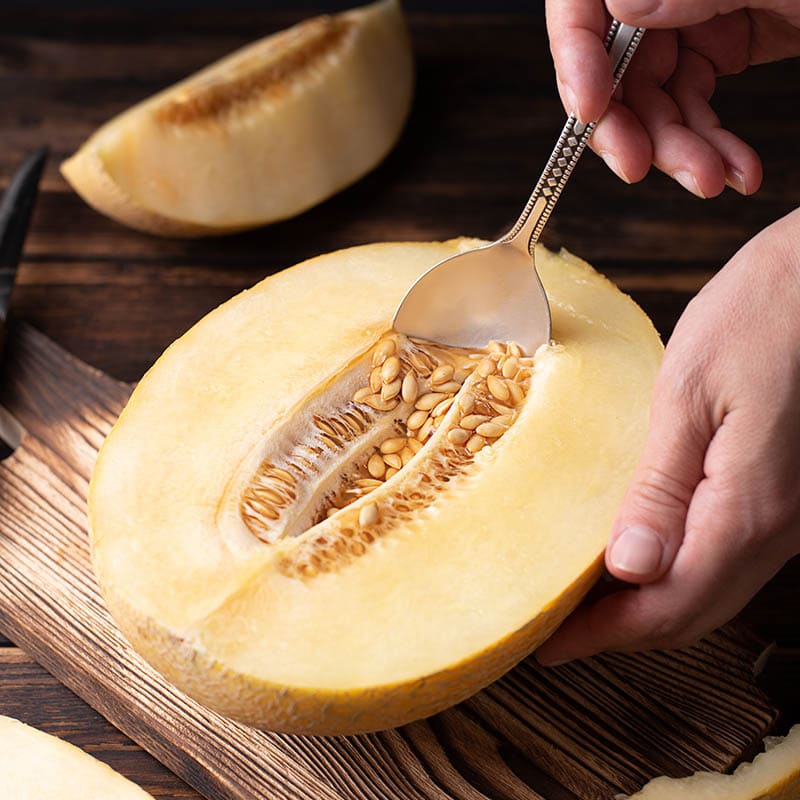
Now that the cantaloupe interior has been unveiled, you can easily remove the seeds with a spoon.
At this stage, your cantaloupe is ready to eat! You can hold each half like a bowl and scoop it with a spoon to enjoy it like the way you used to go with watermelon.
Otherwise, from here you can choose the shape you wish to cut your cantaloupe into. The four methods below will continue cutting from each half of this one.
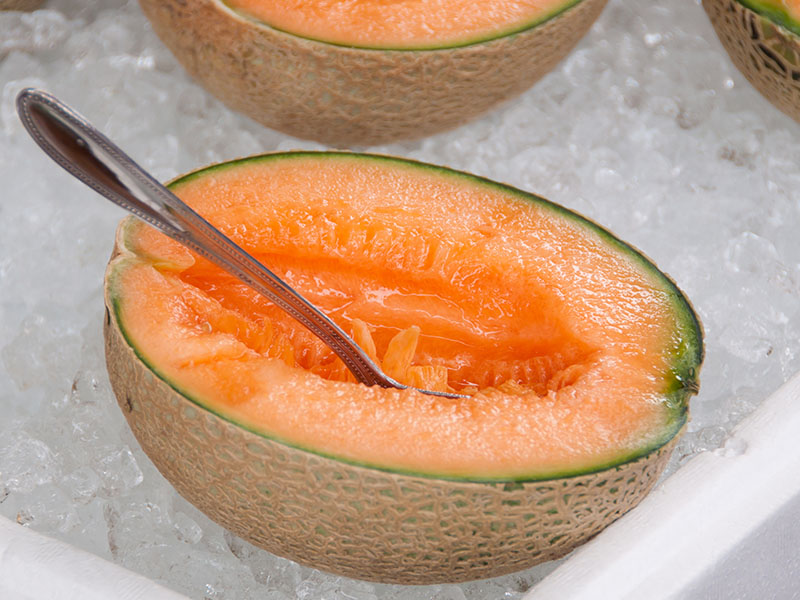
Method 2: Cutting Cantaloupe Into Wedges
The easiest way to enjoy your cantaloupe is to cut them into wedges; you can pick them with your hands and have the deliciousness. There are two options for you to choose from.
Option A: With Rind
Many people will be happier with the perfectly equal wedges of cantaloupe; if you’re one of those, here’s the instruction for you to cut your cantaloupe into the same-size wedges.
Step 1: Lay The Cantaloupe On The Rind Side
After you’ve cut your cantaloupe in half and removed the seeds, lay them on the rind side.
Step 2: Continue To Cut Each Half In Half
Put your knife onto the middle of the opened surface, cut through the flesh of the cantaloupe.
Step 3: Repeat The Process Until You’re Happy With The Wedges
After cutting your cantaloupe in fourth, you can continue cutting them into eighths or more until you reach the desired thickness.
However, this method has two drawbacks. First, since the cantaloupe is round, laying it on the rind, and it’ll bounce back and forth so that you’ll have to hold it carefully while cutting.
Second, you’ll meet the problem of inappropriate thickness due to the proportions of your cantaloupe. The wedges may be too thick after you’ve cut them in eighths but will be too thin if you continue cutting.
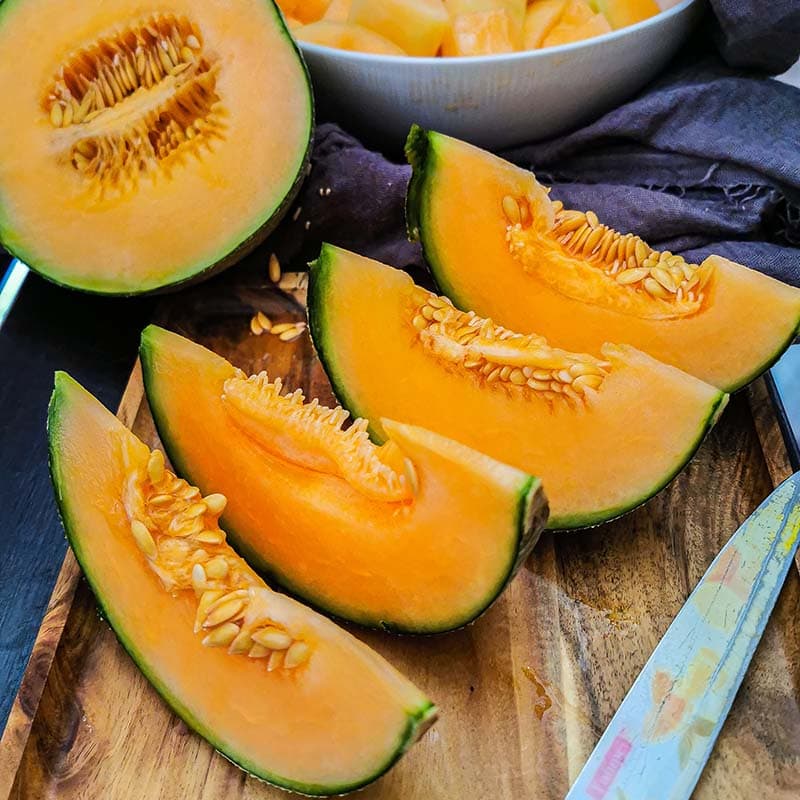
Option B: Without Rind
Instead of laying the cantaloupe on its rind and struggling to hold it in balance, you can peel it first then flip it over and cut it from the outside in. By this method, you can measure the thickness you wish for before cutting.
Step 1: Lay The Cantaloupe On The Flat Side
Lay each half of the cantaloupe by its hollow side.
Step 2: Measure The Thickness You Want
The appropriate thickness of cantaloupe wedges is around 1 to 1 ½ inches on the thickest side of the wedges.
Step 3: Cut Through The Flesh
Put your knife on the outside surface, distant with the cutting board as the thickness you want, while facing its blade to the center of the cantaloupe. Then cut through the flesh while your other hand is holding the cantaloupe.
Step 4: Continue Cutting
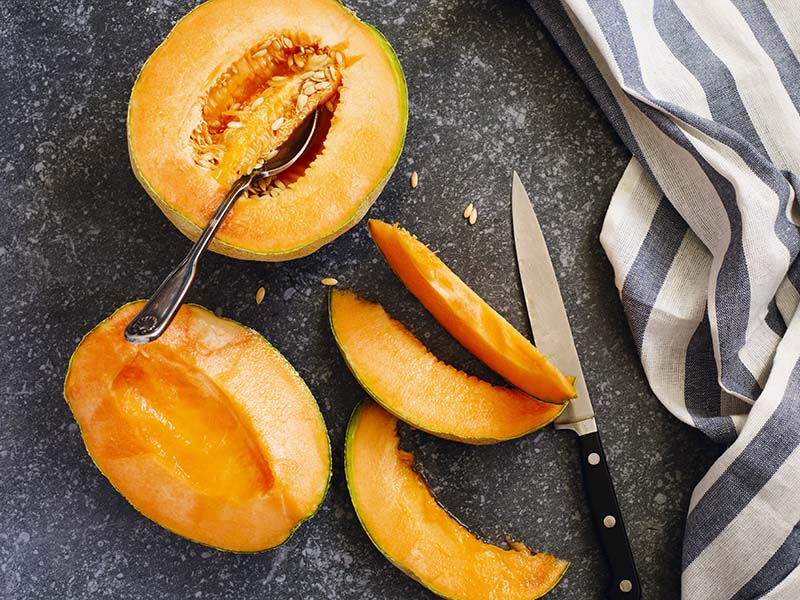
After cutting the first wedge, continue to cut the upper parts; you can cut your cantaloupe from right to left or the other way around, depending on your dominant hand.
Method 3: Cutting Cantaloupe Into Slices
If your cantaloupe is too big to be served in wedges, you can consider turning it around, then slicing it from the stem to the blossom end. This section will show you how to cut your cantaloupe into beautiful slices.
Step 1: Place Your Cantaloupe On The Hollow Side
Continue with the one you’ve cut both ends, split it into half, and remove the seeds. Lay each half on its hollow side.
Step 2: Cut Your Cantaloupe
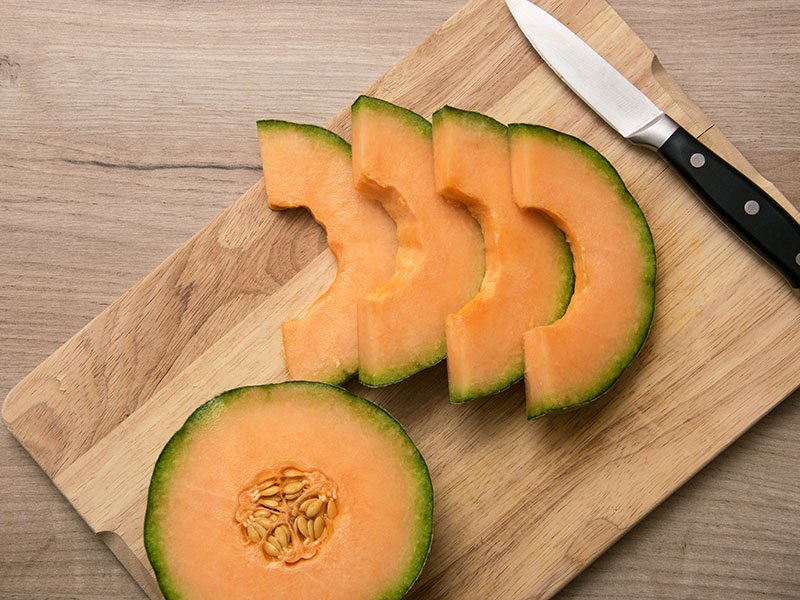
Cut the half cantaloupe from top to bottom by the thickness you’re after while the non-dominant hand holds it. The perfect thickness for cantaloupe slices is no thinner than half an inch and no thicker than 1 inch.
To Remove The Rind From Cantaloupe Slices
You can keep the rind if you want something to hold on to for enjoying your cantaloupe. But If you wish to peel the skin off to be more decorative on the tray or plate, here’s the safe and easy instruction:
Step 1: Stand The Slices On The Rind Side
For easier and safer peeling, lay the cantaloupe slices on their rind side.
Step 2: Slicing The Rind Off
Hold the flesh part of the slice on one hand while the knife-holding hand cuts through the middle between the rind and the flesh.
With this method, you can easily separate the rind and the flesh without worrying about cutting your hands; however, it’s crucial to move your blade firmly lean to the tilt of the cantaloupe.
After you’ve sliced the rind off, you can continue to cut the slices into cubes.
Method 4: Cutting Cantaloupe Into Cubes
If you wish to cut your cantaloupe into cubes and serve them as finger food, here are two options for you to do so.
Option A: With Rind
Step 1: Lay Cantaloupe On It Flat Side
Continue with the half cantaloupe you’ve removed the seeds, lay the hollow-side down.
Step 2: Cut It Into Thick Slices
You can cut in any direction for this method since you’ll have to rotate it later. Vertically cut the cantaloupe halves into thick slices while still holding them together. Note that the thicker the slices are, the bigger the cubes will be.
Step 3: Cut Into Cubes
Rotate your cantaloupe until you can place the knife perpendicular to the previous cuts; then cut it into cubes by the length of the slices.
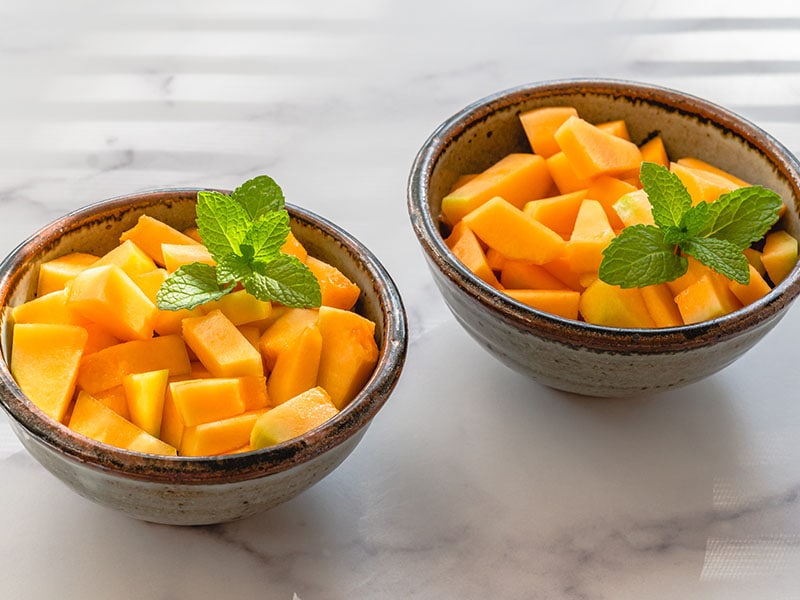
Option B: Without Rind
You can simply peel off the rind of the above method or peel the cantaloupe first, then cut it into cubes. However, I have a more interesting way to create delicious-looking cantaloupe cubes to introduce.
Step 1: Lay The Wedges On Its Thick Side
In this method, you’ll cut through its flesh, not the rind, so stand your wedges up before cutting.
Step 2: Cut The Flesh In Appropriate Thickness
Cut the wedges from top to bottom with the thickness you’re after while the other hand holds the base. Stop when you’ve reached the rind, don’t cut through it.
Step 3: Separate The Rind
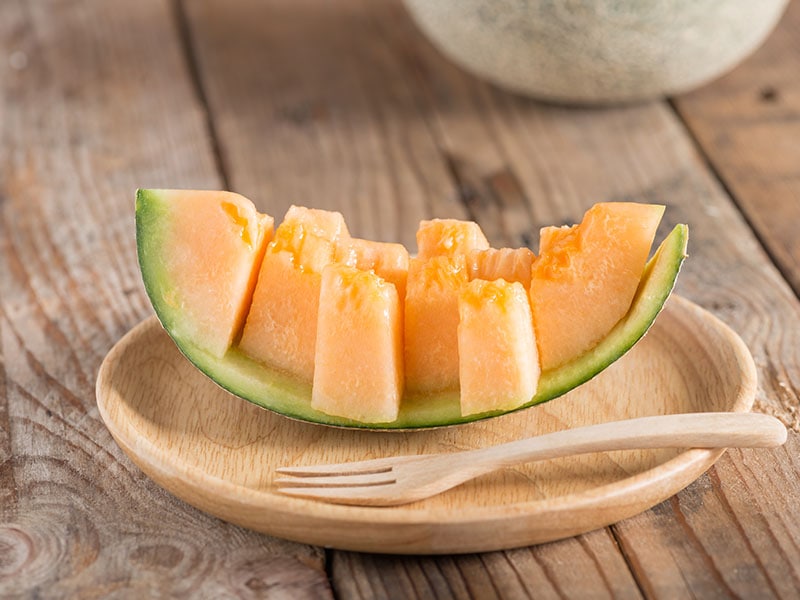
Lean your knife’s blade on the tilt of the cantaloupe and cut through it, and your cubes are ready to serve. I’d rather let them sit on the rind to be more decorative and use forks or small skewers to enjoy the deliciousness.
Method 5: Cutting Cantaloupe Into Spheres
Aren’t watermelon small balls looking so juicy and tasty on hot summer days? Cantaloupe can serve that way as well. Here’s the instruction for eye-catching cantaloupe spheres.
Step 1: Let The Hollow Side On
After you’ve cut your cantaloupe in half and removed its seeds, turn it to the hollow side.
Step 2: Scoop Cantaloupe
Using a watermelon scooper to scoop out the flesh, place those balls into a bowl, and they’re ready to be served.
See how you can make melon balls with just a small scooper.
How To Pick A Delicious Cantaloupe?
The unripe ones tend to be less sweet and a bit crunchy, while the overripe cantaloupe is too mushy to enjoy. Therefore, you’ll want to pick a fresh ripe cantaloupe before getting into the cutting.
First, you’ll want to avoid purchasing cantaloupes with strange or mushy spots on their skin. Then, like other melons, the best way to test cantaloupe is by tapping onto the rind; it should feel tough on the outside but hollow on the inside.
You can also try the ripeness of the cantaloupe by gently pressing on its stem. The good-ripe cantaloupe will release the right aroma, while the overripe ones will give a strong overwhelming smell, and the unripe will provide nothing more than a bark smell.
Check out some simple methods to test the ripeness of cantaloupe.
How To Retain The Freshness Of Your Cantaloupe?
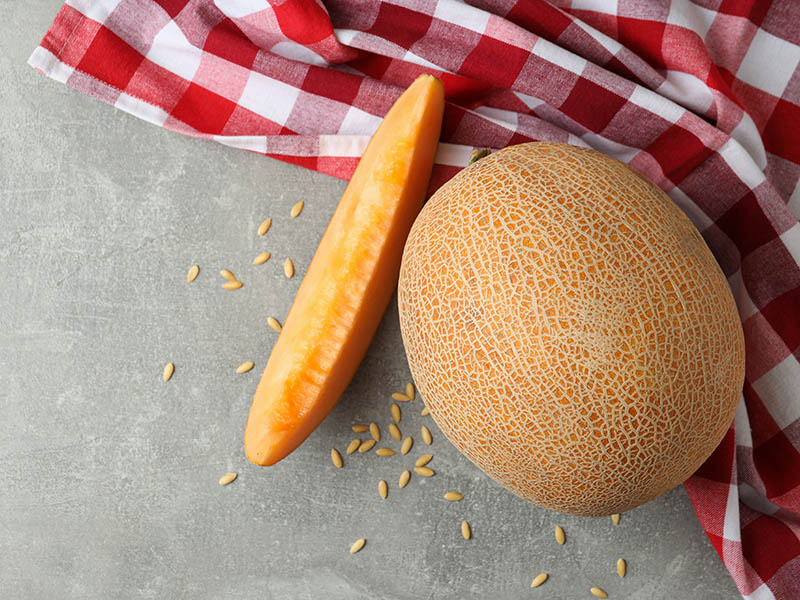
Besides choosing the right cantaloupe, storage is crucial as well if you want to enjoy it, especially if you want to extend the length of time cantaloupes can stay fresh. Storing cantaloupes in the wrong way can eliminate their deliciousness, either whole fruit or the cut ones.
For the unripe cantaloupe, you can let them sit on the counter for a few days, and the fruit will ripen itself; place it nearby ripe bananas or sweetest apple varieties if you wish to promote the ripening.
Avoid direct sunlight and humidity since they’re harmful to your cantaloupe’s skin. With the ripe ones, it’s best to keep them in the fridge and use them within a week or less.
To the cut cantaloupe that you don’t have an immediate plan to enjoy, put them in a plastic bag or box, then place them in the fridge; this is the best way to retain the juicy and freshness of the cut cantaloupe, but consider tossing them after a week.
FAQs
At this stage, I’m positive that you’re ready to cut your cantaloupe into the desired shape and enjoy it. However, you may need some more facts about this wonderful fruit, here are some of the most asked questions that will provide those.
Now: Let’s Enjoy Your Juicy And Refreshing Cantaloupe!
After walking through this article, you now can confidently cut your cantaloupe into the desired shape, slices, wedges, cubes, or spheres, totally up to you. However, ensuring the ripeness of it before cutting is a must.
Are you satisfied with the information? Share it with your beloved people so they can know how to cut and serve delicious cantaloupes.
Don’t forget to share your experiences in the comment section! Other readers and I expect you have some useful tips to tell. Then, you can enjoy your delicious-looking cantaloupe!
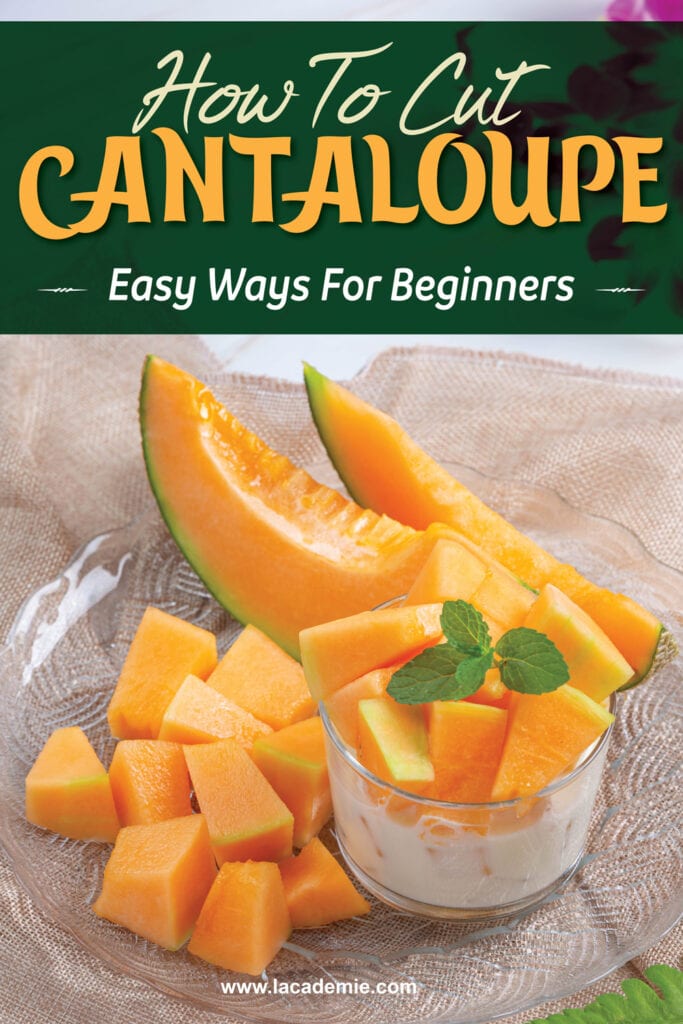
References
- Healthline. 2022. Benefits of Cantaloupe: 7 Healthy Advantages.
- Food Safety News. 2022. Cantaloupe: Sometimes a Rough Fruit.


